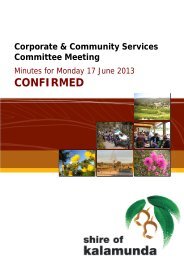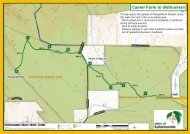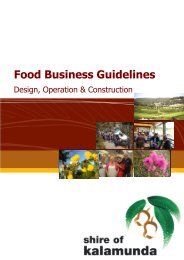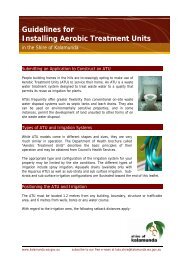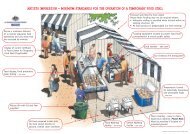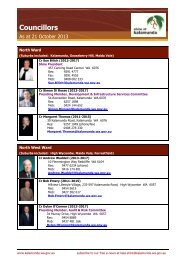Local Biodiversity Strategy: - Shire of Kalamunda
Local Biodiversity Strategy: - Shire of Kalamunda
Local Biodiversity Strategy: - Shire of Kalamunda
Create successful ePaper yourself
Turn your PDF publications into a flip-book with our unique Google optimized e-Paper software.
Developers may be able to take advantage <strong>of</strong> this tax benefit by using the tax<br />
deduction for gifting a natural area that is above the statutory requirement.<br />
The <strong>Shire</strong> could work with a suitable deductible gift recipient (such as the Worldwide<br />
Fund for Nature, Greening Australia or the National Trust) to promote this tax benefit<br />
with developers during the structure planning phase. It is only likely to appeal to a<br />
developer if they own land that can be developed as a number <strong>of</strong> residences. Only<br />
large natural areas (greater than 4ha) in good condition or land areas attached to<br />
the Public Open Space allocation to increase its<br />
area should be encouraged for gifting.<br />
11.7 Private Land Conservation<br />
Of the remaining LNAs occurring within the<br />
<strong>Shire</strong>, 1475 ha <strong>of</strong> vegetation occur on privately<br />
owned land (Perth <strong>Biodiversity</strong> Project, 2004<br />
unpublished data sets). This represents a 67.7%<br />
<strong>of</strong> the remaining LNAs, especially with regards<br />
to the threatened Forrestfield and Southern<br />
River vegetation complexes that occur on the<br />
Swan Coastal Plain.<br />
Calothamnus rupestris (Mouse Ears)<br />
Natural areas on private land may be fragmented, degraded or in excellent condition,<br />
depending on their past use. There are opportunities for natural areas covering a<br />
number <strong>of</strong> properties to be grouped together to form a viable natural area. LNAs on<br />
private land can also provide a buffer to the biodiversity on reserves or National/<br />
Regional Parks.<br />
Some landowners are knowledgeable and experienced managers <strong>of</strong> their bushland,<br />
though most owners would benefit from encouragement and opportunities to<br />
increase their knowledge. The development <strong>of</strong> a private land conservation incentives<br />
strategy by the <strong>Shire</strong> could assist landowners in this regard.<br />
Private land conservation incentives strategy details a package <strong>of</strong> planning, financial<br />
and non-financial incentives that could be made available to landholders who<br />
voluntarily choose to protect and manage biodiversity values on their property. An<br />
incentives strategy is essential for raising landholder awareness and their capacity to<br />
identify, protect and manage their natural resources.<br />
Private land conservation provides a variety <strong>of</strong> benefits in addition to biodiversity<br />
outcomes. For example, economic benefits <strong>of</strong> retaining vegetation include prevention<br />
<strong>of</strong> wind and water erosion, improved management <strong>of</strong> salinity, provision <strong>of</strong> shade and<br />
shelter and a natural means <strong>of</strong> controlling pests.<br />
For private land conservation strategies to be effective, they need to be tailored to<br />
meet the requirements <strong>of</strong> the <strong>Shire</strong> and the landowners. This can be achieved in a<br />
number <strong>of</strong> ways including surveys, focus groups and other community engagement<br />
processes. In this way resources can be focused on incentives that are most likely to<br />
appeal to the residents and to achieve the outcomes being sought.<br />
<strong>Local</strong> <strong>Biodiversity</strong> <strong>Strategy</strong> Page 77



